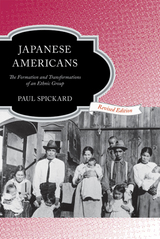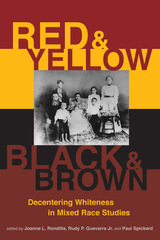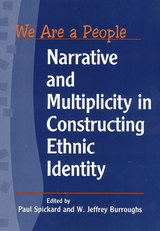3 books about Spickard, Paul

Japanese Americans
The Formation and Transformations of an Ethnic Group
Spickard, Paul
Rutgers University Press, 2008
Since 1855, nearly a half a million Japanese immigrants have settled in the United States, the majority arriving between 1890 and 1924 during the great wave of immigration to Hawai'i and the mainland. Today, more than one million Americans claim Japanese ancestry. They came to study and to work, and found jobs as farm laborers, cannery workers, and railroad workers. Many settled permanently, formed communities, and sent for family members in Japan. While they worked hard, established credit associations and other networks, and repeatedly distinguished themselves as entrepreneurs, they also encountered harsh discrimination. Nowhere was this more evident than on the West coast during World War II, when virtually the entire population of Japanese Americans was forced into internment camps solely on the basis of their ethnicity.
In this concise history, Paul Spickard traces the struggles and achievements of Japanese Americans in claiming their place in American society. He outlines three forces shaping ethnic groups in general: shared interests, shared institutions, and shared culture, and chronicles the Japanese American experience within this framework, showing how these factors created and nurtured solidarity.
[more]

Red and Yellow, Black and Brown
Decentering Whiteness in Mixed Race Studies
Rondilla, Joanne L
Rutgers University Press, 2017
Red and Yellow, Black and Brown gathers together life stories and analysis by twelve contributors who express and seek to understand the often very different dynamics that exist for mixed race people who are not part white. The chapters focus on the social, psychological, and political situations of mixed race people who have links to two or more peoples of color— Chinese and Mexican, Asian and Black, Native American and African American, South Asian and Filipino, Black and Latino/a and so on. Red and Yellow, Black and Brown addresses questions surrounding the meanings and communication of racial identities in dual or multiple minority situations and the editors highlight the theoretical implications of this fresh approach to racial studies.
[more]

We Are A People
Paul Spickard
Temple University Press, 2000
As the twentieth century closes, ethnicity stands out as a powerful force for binding people together in a sense of shared origins and worldview. But this emphasis on a people's uniqueness can also develop into a distorted rationale for insularity, inter-ethnic animosity, or, as we have seen in this century, armed conflict. Ethnic identity clearly holds very real consequences for individuals and peoples, yet there is not much agreement on what exactly it is or how it is formed.
The growing recognition that ethnicity is not fixed and inherent, but elastic and constructed, fuels the essays in this collection. Regarding identity as a dynamic, on-going, formative and transformative process, We Are a People considers narrative -- the creation and maintenance of a common story -- as the keystone in building a sense of peoplehood. Myths of origin, triumph over adversity, migration, and so forth, chart a group's history, while continual additions to the larger narrative stress moving into the future as a people.
Still, there is more to our stories as individuals and groups. Most of us are aware that we take on different roles and project different aspects of ourselves depending on the situation. Some individuals who have inherited multiple group affiliations from their families view themselves not as this or that but all at once. So too with ethnic groups. The so-called hyphenated Americans are not the only people in the world to recognize or embrace their plurality. This relatively recent acknowledgment of multiplicity has potentially wide implications, destabilizing the limited (and limiting) categories inscribed in, for example, public policy and discourse on race relations.
We Are a People is a path-breaking volume, boldly illustrating how ethnic identity works in the real world.
The growing recognition that ethnicity is not fixed and inherent, but elastic and constructed, fuels the essays in this collection. Regarding identity as a dynamic, on-going, formative and transformative process, We Are a People considers narrative -- the creation and maintenance of a common story -- as the keystone in building a sense of peoplehood. Myths of origin, triumph over adversity, migration, and so forth, chart a group's history, while continual additions to the larger narrative stress moving into the future as a people.
Still, there is more to our stories as individuals and groups. Most of us are aware that we take on different roles and project different aspects of ourselves depending on the situation. Some individuals who have inherited multiple group affiliations from their families view themselves not as this or that but all at once. So too with ethnic groups. The so-called hyphenated Americans are not the only people in the world to recognize or embrace their plurality. This relatively recent acknowledgment of multiplicity has potentially wide implications, destabilizing the limited (and limiting) categories inscribed in, for example, public policy and discourse on race relations.
We Are a People is a path-breaking volume, boldly illustrating how ethnic identity works in the real world.
[more]
READERS
Browse our collection.
PUBLISHERS
See BiblioVault's publisher services.
STUDENT SERVICES
Files for college accessibility offices.
UChicago Accessibility Resources
home | accessibility | search | about | contact us
BiblioVault ® 2001 - 2024
The University of Chicago Press









